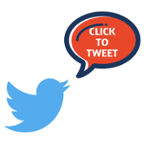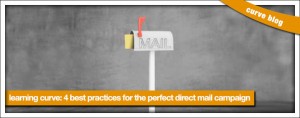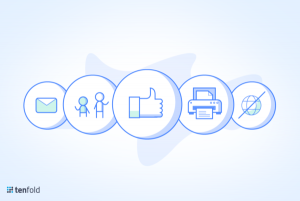
Can a boring, unsexy B2B company rock social media?
You bet!
Marketing guru, Jay Baer, says it best:
“Social media can be MORE transformative for a B2B company than a B2C company… because B2B has a smaller potential customer base, a higher average price point.”
So how can you get some of that transformational juice for your own B2B small business or larger company?
By the end of this post, you’ll know:
- Why social media is important for your small business marketing — and for larger businesses too
- Which platforms to use
- What type of content to post
- How and when to complement your social media with paid media
Why Social Media is Important to Your B2B Small Business Marketing Strategy
Let’s go back to the argument about the B2B sector being too boring for social media. Does this hold any water?
It does if you believe that social media is nothing but a big advertisement for your company.
However, if you’re looking at social media the way the marketing gods intended, you know that it isn’t meant to be a giant billboard for your company. Rather social media is intended to be a tool to build awareness, create relationships, and display the human side of your company. Given those benefits, doesn’t it make sense that social media is perhaps even more important to B2Bs?
For instance, even if you love Starburst candies, do you really want to build a relationship with them? Would you follow them on social media for weeks, months, and years before deciding to buy their newly-launched line of candy? Probably not. The investment is too small to exhaust that kind of time and mental energy.
However, if you’re deciding which company to use to manufacture parts for your equipment, wouldn’t you want to know the company’s background? Wouldn’t you approach that relationship with a little more diligence than you would a relationship with your mid-afternoon sugar fix supplier?
“55% of B2B buyers say they search for product/vendor information on social media.” ~ Meltwater
Yes, social media is critical to the success of any B2B small business or medium-size company. However, if you’re not just promoting your product, what do you post? And what platforms do you use
Social Platforms and Content Tips for B2B Small Businesses
The good news is that there are few hard and fast rules to using social media for your small or medium-size business. What works well for one company, may not work well for yours. However, there are some general guidelines to follow.
Let’s discuss how to use the big three social media titans: Twitter, Facebook, and LinkedIn.
What it’s used for: Distributing helpful content typically related to business and industry
What to post there: Links to your blog posts, helpful industry information, retweets and promotion of customers, partners and industry influentials
How often you should post: At least several times per day; it’s OK to post the same content multiple times since you’ll likely be reaching a different audience. Chances of someone seeing your post at 10:30 am and 2:00 pm are pretty slim.
Twitter is saturated with content. And that’s not necessarily a bad thing. This is because as long as hashtags are applied, it’s very easy to catalogue and search for relevant information. So go ahead and start posting.
What it’s used for: Sharing emotional content, engaging with followers on a personal and even local level
The type of content you should post there: Your company’s involvement in local events, funny and heartwarming reposted content, milestones in your company
How often you should post: This depends largely on your audience — once or twice a day is likely sufficient for your small business or medium-size firm.
Helpful tips: Make sure you open a business page and have it verified by Facebook, respond quickly to comments, upload video natively as Facebook favors native posts (do not simply share a link from your YouTube account), do not post using a scheduler like Hootsuite (Facebook favors organic posting), make good use of Facebook Live
Keep in mind that most of us are scanning Facebook over our morning coffee, or when we need a mental break from the workday. Therefore, you’ll want to post content that is positive and informative, but a little more on the light side.
What it’s used for: Networking and helping others by sharing useful content and innovative thoughts
The type of content you should post there: Links to your blog posts (you can also create posts right in LinkedIn using LinkedIn Pulse), informative industry articles and news
How often you should post: No more than once or twice per day
Helpful Tips: LinkedIn should not be looked at as a marketing platform, but rather a place where like-minded people can collaborate. LinkedIn is not a place to gather email addresses for marketing purposes. Lastly, although you want a personal LinkedIn profile, you should also create a LinkedIn company profile to highlight the ins and outs of your business.
Want any more reasons to use LinkedIn? Here’s a telling statistic:
LinkedIn drives the most customers to B2B (65%). ~ Hubspot, State of Inbound
This just goes to show that B2B social media is at its best when it’s not trying to sell. That is really the fundamental principle of inbound marketing: To provide useful content that draws prospects to your website. The goal is not direct selling or instant conversion. Rather it’s to be helpful — the very aim of LinkedIn.
Should You Complement Your Social Media with Paid Media?
If you are already regularly posting to your Facebook business account, you know that Facebook tells you when a post is performing particularly well. That’s followed by the query: “Do you want to boost this post to reach more people for $ XX?”
You may have wondered if this is really effective. Should you actually pay money on the off chance you’ll reach the right person who become a customer?
First, let’s talk about two avenues of this type of media.
Retargeting. This is perhaps the cheapest form of paid media and it’s very simple to do. Let’s say Mr. Prospect visits your website. He leaves without filling out any form, he doesn’t contact you, you don’t know he even visited your site. However, by installing a Facebook pixel code on your website, when Mr. Prospect heads over to his Facebook feed, he starts seeing advertisements for your company. He starts to build a profile of your business and the products you offer. It seems you are everywhere!
Paid Ads: These are the ads that pop up on the side of your Facebook feed, or as sponsored Twitter or Instagram posts. These are somewhat risky since to some extent you are leaving the target audience selection up to the platform. In addition, there are often strict rules as to what type of ad you may create. For instance, Facebook allows no more than 20% of your ad space to be text. You are also limited to 90 characters. Ever try to catch someone’s eye with an ad the size of a couple of postage stamps and that’s largely image-based? It’s not easy, as you may imagine.
The Bottom Line: If you have the budget, go ahead and use media that costs. However, you need to make sure your ad is of professional quality. Lastly, don’t get your hopes up that the phone will be ringing off the hook as soon as the ad launches. It takes time to nurture leads.
I hope this crash course in using social and paid media for your B2B small business has been useful. Want more content to help grow your business? Subscribe to my blog, using the form on the right. And be sure to share your thoughts with me!
Digital & Social Articles on Business 2 Community
(27)





